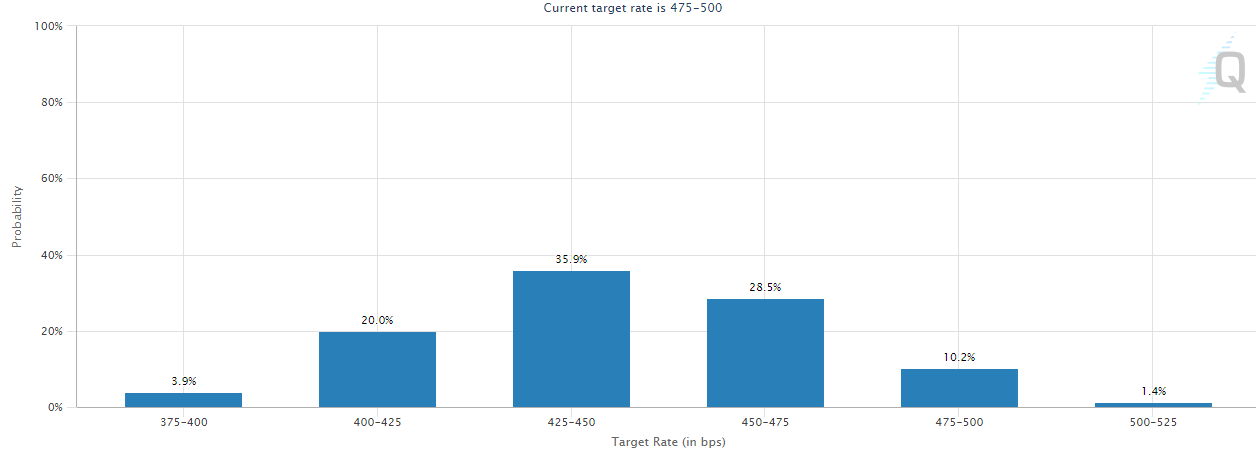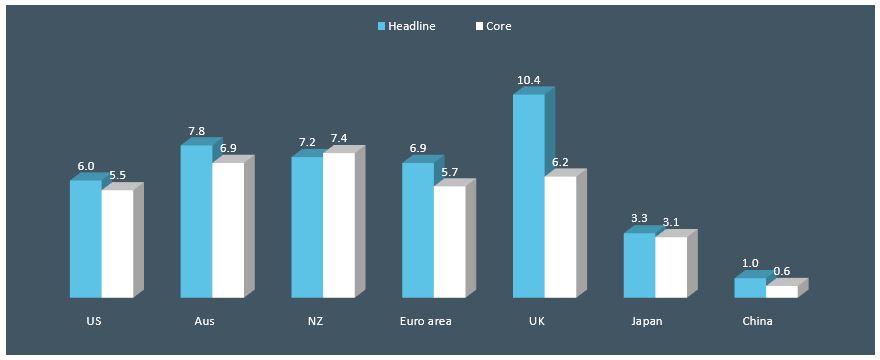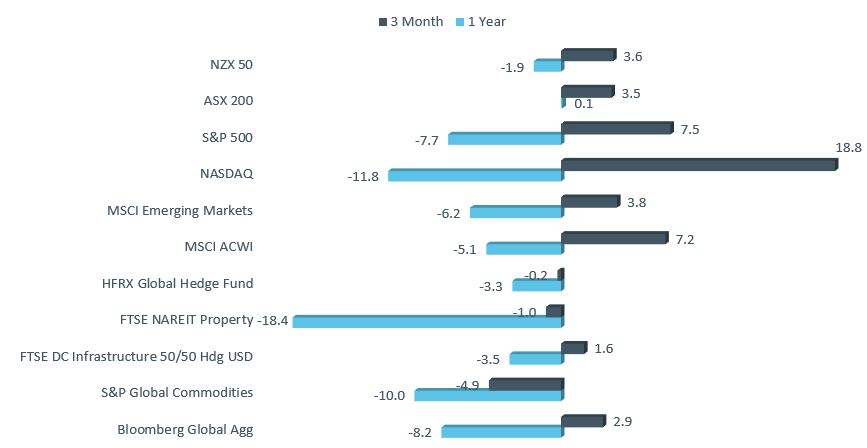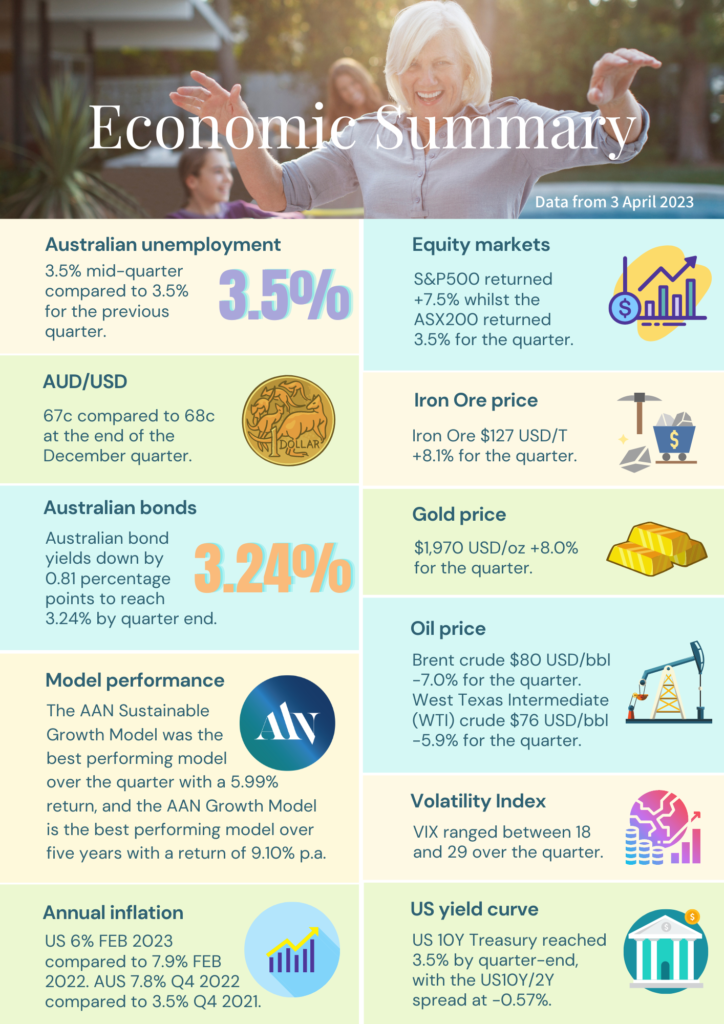Schedule a Chat
Contact Info
Suite 17.03, Level 17
20 Bond Street
Sydney NSW 2000

INSIGHTS WITH EVALESCO
TOPICS DISCUSSED
Despite uncertainty in markets, stemming from the banking sector, investment returns were positive across most asset classes for the first quarter of 2023.
The major catalyst for volatility over the quarter stemmed from the collapse of Silicon Valley Bank (SVB) and Signature Bank in the US. The risks faced by these banks were known and ultimately came down to the imprudent maturity mismatching of assets and liabilities within a rising interest rate environment.
Through periods of financial instability emotion can get the best of investors, causing panic, and accelerating undesirable outcomes. Significant redemptions on term deposits, in a short space of time, meant these banks had to sell debt securities at a significant loss (given rapid increases in interest rates) to satisfy the redemption requests. US bank regulators identified the potential contagion risks to the broader market early and decided to guarantee investors’ term deposits stem the potential losses.
Credit Suisse in Europe also ran into strife, though this followed years of scandals, losses, and changes to the management team which caused clients to withdraw billions from the bank. In mid-March UBS bought Credit Suisse for approximately 3 billion CHF (almost US$3.3 billion).
A consequence to the above mentioned issues, is there is now expected to be a greater focus on restoring bank capital ratios, with more acute regulatory oversight, whilst also having to contend with higher funding costs. This will put greater pressure on bank profits, which will likely have a flow on effect through to other sectors, as banks will not be able to facilitate lending as freely, which typically has a slowing effect on economic growth. This is on top of an already tight credit environment.
Adjustments to economic growth and monetary policy forecasts followed as the quarter ended. The Fed ultimately made two hikes of 25 bps during the quarter to reach 4.75%-5.00%. Post quarter-end the market was pricing only an 11.6% chance of the US Fed rate being 4.75%-5.00% or higher (see the far right of Figure 1 below). This was a significant change from only one month earlier, where the market was pricing in a 75.8% chance.

Figure 1: Target Rate Probabilities for 13 December 2023 Fed Meeting, calculated in April. Source: CME FedWatch Tool
The Reserve Bank of Australia (RBA) decided to maintain the cash rate at 3.60% at the April meeting, but there is still a good chance of a 0.25 percentage point (pp) increase in the May meeting. The Governor’s guidance softened to indicate a possible further tightening of monetary policy “may well be needed” instead of saying it “will be needed”. The RBA paused to assess the impact of the shift in policy stance and will assess the global economy, household spending trends, inflation, and the labour market outlook. Weakness in productivity growth is of concern for the RBA, and they will need to consider recent surging population growth (through larger than normal immigration) and wage growth, in their deliberations. The next Board meeting is in May. The Board is currently expecting inflation to return to the 2-3% target zone by mid-2025, highlighting the current patient approach.
Conversely, across the Tasman the Reserve Bank of New Zealand (RBNZ) raised the cash rate by 0.50pp, which was more than what was anticipated. The RBNZ is taking a firm stance on inflation. Due to persistent high inflation, the RBNZ will likely continue to prioritise tightening monetary policy for the foreseeable future. Another increase is expected in May where the terminal rate could end up at 5.5%.
Central bank hikes continued in Europe (two 0.50pp hikes) and the UK (0.50pp then 0.25pp) during the quarter where inflation remains elevated (Figure 2). Inflation in Europe fell, but by less than expected, whilst headline inflation in the UK continued higher, moving from 10.1% to 10.4%.
The Bank of Canada raised its interest rates by 0.25pp, but immediately signalled a halt to any further increases.
Meanwhile, despite a rise in core inflation, the Bank of Japan did not make any changes to its policy of controlling the yield curve. The appointment of a new governor by the Bank of Japan is being evaluated by the markets for any impact on monetary policy, particularly regarding the management of the yield curve.

Figure 2: Annual inflation rates by quarter-end. Source: Trading Economics
After a challenging year in 2022, ongoing global uncertainty and further tightening from central banks, risk asset markets across the world saw substantial positive returns during the first quarter of 2023 (Figure 3).
Regarding equity markets, whilst the headline return was positive for the quarter, a look underneath the bonnet suggests the returns were primarily driven by only a few sectors. A good comparison to demonstrate this is the return of the equal weighted S&P 500 (2.9%) against the usual market cap index (7.5%), where returns from heavyweights Apple (25%), Meta (75%), Microsoft (19%), Nvidia (90%) and Tesla (65%) pushed the market cap index higher. Over the one-year period, notably, the only positive equity market was the ASX 200.

Figure 3: Investment returns over three months and one year to 31 March. Source: FE Analytics
What’s next?
Caution is recommended, with the path of inflation being the major risk to financial markets. The outlook for inflation is still uncertain and varies across economies. Central banks are getting closer to the top of the rate hike cycle, some closer than others. Rates are likely to stay elevated to tackle the stickier inflation components and ensure inflation doesn’t become more engrained into expectations. Goods inflation has receded somewhat; however services inflation is stickier, given it is less sensitive to supply chains easing and monetary policy decisions.
In a tight interest rate environment, it remains prudent to be aware of the bottom-up risks as demonstrated within the banking sector through the quarter. Macro factors have driven much of the returns over the past year, though as the first quarter of 2023 shows, pressure is building at the corporate level with not-so-favourable outcomes for investors starting to reveal themselves. The risk of defaults is increasing and corporate earnings are under pressure.
At the asset class level, higher rates now mean that cash and fixed interest offer a more attractive option in a diversified portfolio. Regarding the latter, it will be important to consider credit quality and liquidity.
A focus on investment fundamentals, ongoing due diligence, and regular portfolio reviews is necessary as we move through what will likely be a sustained period of market stress and volatility in 2023.

You can download the entire Quarterly Investment Update HERE
Regards,
Marshall Brentnall, and the AAN Investment Committee
SHARE OUR INSIGHTS
Share on Facebook
Share on Email
Share on Linkedin

NEWSLETTER

Evalesco Financial Services Level 17, 20 Bond Street Sydney NSW 2000
Phone: (02) 9232 6800
The information provided on and made available through this website does not constitute financial product advice. The information is of a general nature only and does not take into account your individual objectives, financial situation or needs. It should not be used, relied upon, or treated as a substitute for specific professional advice. We recommend that you obtain your own independent professional advice before making any decision in relation to your particular requirements or circumstances. Evalesco Financial Services do not warrant the accuracy, completeness or currency of the information provided on and made available through this website. Past performance of any product discussed on this website is not indicative of future performance. Copyright © 2019 Evalesco Financial Services. All rights reserved